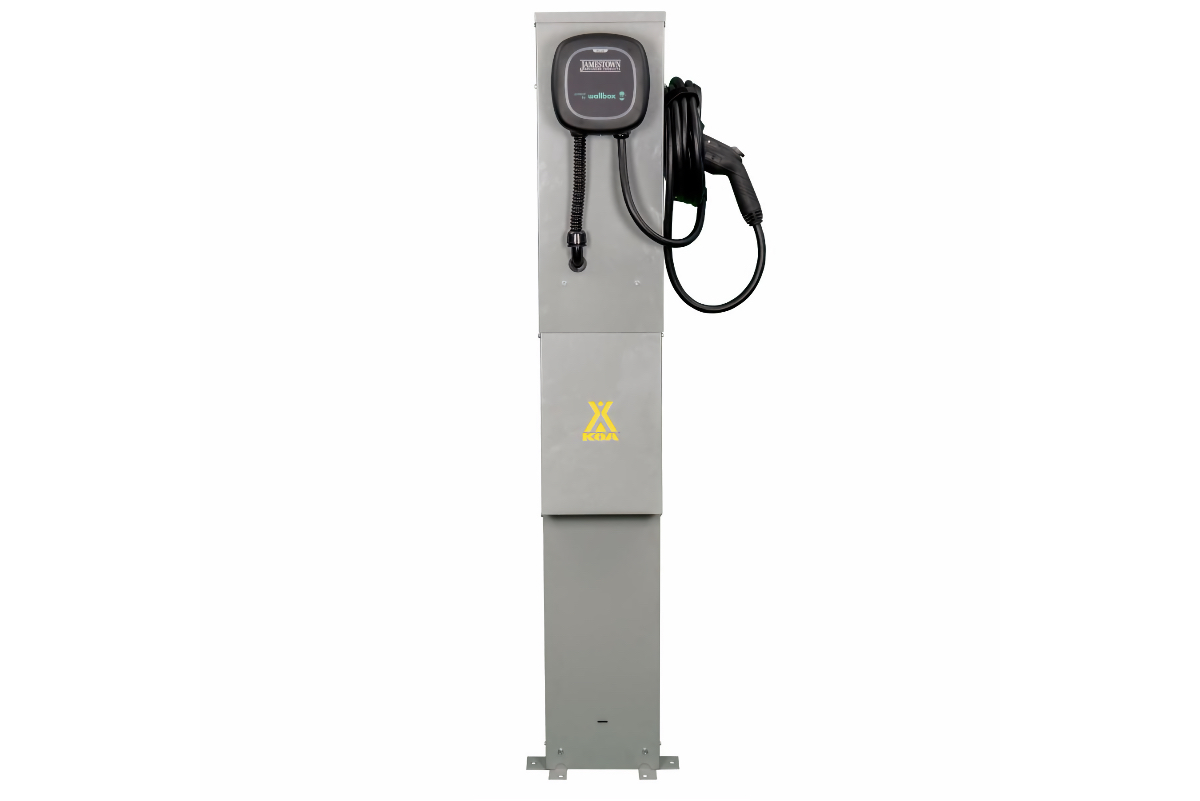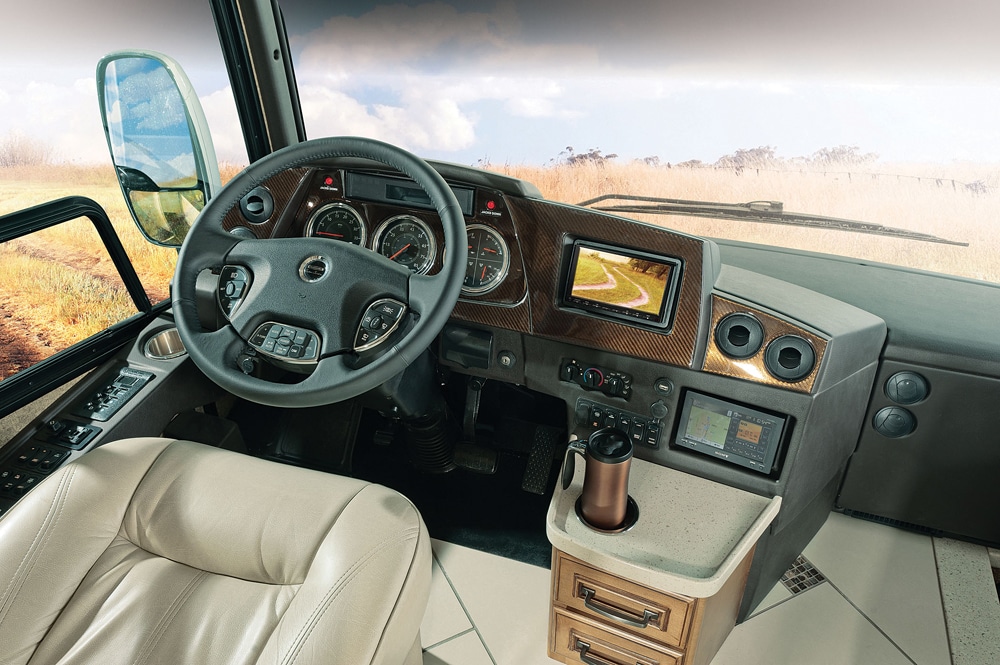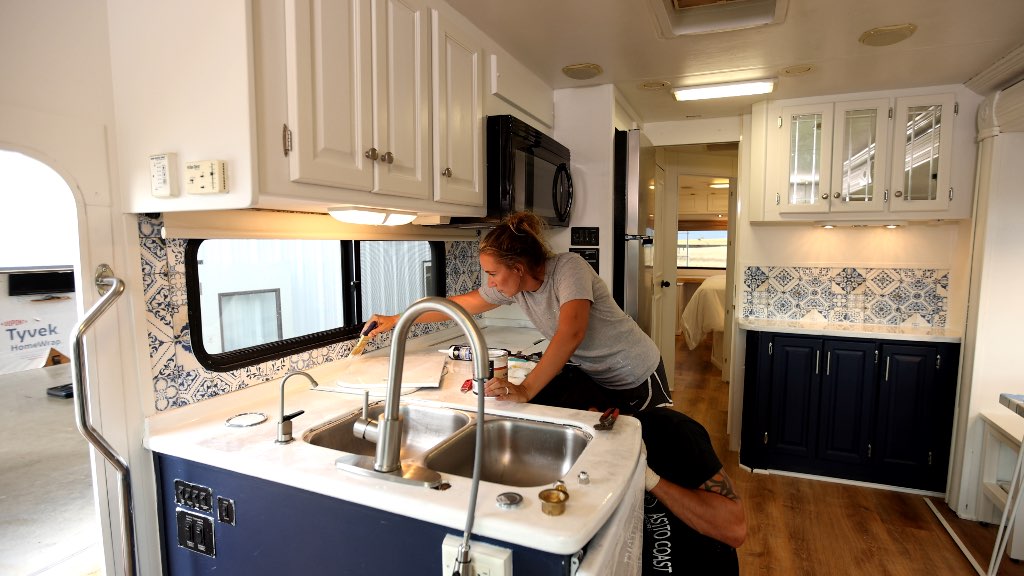Tech Q&A — July, 2022
DEF 101, a Slideout with the Lights Out, Looking for Lithium Batteries, a Hitch-Ball Soda Can, and EV Charging
Image Caption:
Diesel Exhaust Fluid (DEF)
Q: We recently bought a new 2022 Ford Power Stroke diesel-powered pickup to tow our 35-foot fifth wheel. We’ve never had a diesel before, and besides the higher cost of diesel fuel relative to the already high prices of gasoline, we are concerned about the cost and frequency of adding DEF. What is it made of, what does it do, and can the system be disabled or bypassed?
-Jeff Stevens, Dallas, Texas
A: Diesel Exhaust Fluid (DEF) is a liquid mixture of water (67.5%) and urea (32.5%) that is metered and injected into a diesel engine’s exhaust stream. The DEF is necessary for the operation of the Selective Catalytic Reduction (SCR) emission control system. The SCR system converts oxides of nitrogen, which are formed in combustion, back into nitrogen and carbon dioxide. Most diesel trucks sold in the USA since mid-2010 come with this system. DEF fluid helps reduce the amount of noxious nitrogen oxides from diesel engine exhausts.
The DEF helps diesel engines meet EPA emission requirements but is said to not reduce performance or fuel effciency. Some truck owners remove the SCR system and eliminate the need for DEF. However, this is illegal and will cause the truck to fail an emissions test. Removal of the SCR system can also void the vehicle’s warranty, many dealers won’t work on a truck with the SCR deleted, and it may be illegal to sell the modified vehicle.
The EPA required that all highway diesel engines made after January 1, 2010 meet their new emissions standard. DEF is used in current Chevrolet, GMC, Ford, and RAM diesel trucks, along with many diesel motorhomes.
The rate of DEF consumption depends on the engine and load. The more fuel you use, the more DEF you will use. There are many variables, just as with fuel economy, including a truck’s size, the load or trailer it’s hauling, and terrain, wind, and traffic. When not towing, many diesel pickups get around 18–22 mpg, but only achieve perhaps 8–12 mpg when towing. More DEF is consumed if you’re towing a heavy trailer. Owners not towing or hauling heavy loads sometimes report getting 6,000–8,000 miles on a tank of DEF, and perhaps 3,000–4,500 miles while towing.
If the DEF runs low, the instrument panel will show a warning when there are about 500 miles until the DEF is used up. at should be enough warning to find some more. DEF is sold in large plastic containers at auto-parts stores, filling stations, and truck stops. The most economical way to buy it is at the fuel pump of truck stops, where it is dispensed in bulk next to the diesel fuel pumps.
If you do not heed the warning, the engine computer will derate output to a lower power mode. This reduction in power helps conserve the remaining DEF in the tank. The engine will remain in low power mode and keep running until the engine is shut off, for safety’s sake, to allow vehicle control. However, if you don’t refill the DEF, the engine will not restart. There are plenty of dashboard warnings before this happens.
The owner’s manual contains a complete explanation about the DEF system and its use and maintenance.
Lithium Iron Phosphate Batteries
Q: I have a 2018 Grand Design Solitude trailer. I am looking to buy a LiFePO4 battery for it. Can I just drop it in and go? Will it charge my tow vehicle and the inverter the same as a lead-acid battery?
– Brant Bizzo, via email
A: Lithium iron phosphate batteries are considerably more expensive, but far lighter and deliver an increased number of charge/discharge cycles compared to lead-acid batteries. They can also be discharged more deeply compared to lead-acid, down to 20% or even 0% in some cases of their rated capacity without harming them, compared to about 50% on other types of batteries. Most LiFePO4 batteries can only be safely charged between 32° F–113° F (0° C–45°C). You didn’t provide your location, so I can’t make specific recommendations for you.
They also don’t charge well from a standard converter/inverter or charger that’s only rated for flooded cell or AGM lead batteries. Check yours to see if it has a setting for lithium batteries. Typically, only the ones made in the last few years have the needed setting. Charging a lithium battery from a converter/inverter set for lead-acid or AGM batteries can shorten the life of the battery by half or more and reduce its output. They typically only recharge the lithium batteries up to about 80% charge. Progressive Dynamics has a converter/charger that’s compatible with lithium batteries if you need one.
You can charge a lithium battery from your tow-vehicle alternator but not necessarily to full charge because most voltage regulators are adjusted for the lower voltage needs of a lead-acid battery (approximately 13.9 volts, while lithium batteries require about 14.4–14.6 volts to fully charge. When you get to a campground and plug in, the converter/inverter will finish charging the battery.
Lights Out!
Q: We have a 2020 Winnebago View Class C. We installed new batteries and checked fuses, but the ceiling lights in a slide-out stopped working. The same type of light above the overhead cab bed works. Everything else is OK. What could it be? Is it a fuse I missed?
– David Simmons, via email
A: Remove the switch for the lights and check for 12-volt power there. If you don’t have power at the switch, remove each fuse and check them carefully with an ohmmeter. If there is power at the switch but it’s not getting through to the lights, the switch may be bad. Another possibility is that the wire going to the lights in the slide-out are damaged or disconnected. Extend the slide and look for the wiring. You didn’t mention which View floorplan you have, and there are three different wiring diagrams for them. There’s an excellent free resource on Winnebago’s website which includes wiring diagrams that can be found here.

Image Courtesy of Kampgrounds of America
Charging Electric Vehicles
Q: This note is in regard to the comments in the January issue about charging electric vehicles (EVs) while staying at a campground. In Canada, more and more campgrounds are now equipped with charging stations for electric cars. We have seen many in Québec and in Ontario and have heard that it is also a trend in British Columbia and the Canadian Maritime provinces. Since we have not been allowed to travel to the US (one of our favorite playgrounds) in the last two years, I would be interested to know if it is a growing tendency south of the border. Thanks for your always interesting articles.
– Yvan Jérôme, Laval, Québec, Canada
A: This is a rapidly evolving subject. KOA is working with Jamestown Advanced Products to provide Level 2 charging stations at some KOA campgrounds. There are a few RV park owners in the US who have already installed standalone, pay-to-plug-in EV charging stations at their parks. Some others may have a protocol and fees for charging an EV using the regular campground power outlets. The electricity to fully charge an EV typically costs in the neighborhood of $15, depending, of course, on local rates.
As things open up post-COVID-19, RV parks are very busy and reservations are strongly recommended. While you are making the reservations, inquire about their policies on charging EVs. RV sites, state parks, and national parks with 50-amp or 30-amp hookups should work with a Tesla or other model if you have the proper adapter. Use the vehicle manufacturer’s website to check out what exact adapters you would need. To connect to a 50-amp outlet, you will need a Tesla 14-50 adapter. I would enjoy hearing from readers who camp with electric vehicles on what their experiences have been.
Internet Reception
Q: My wife and I are looking to spend more time on the road, but we need to extend our internet reception due to remote work commitments. Where do I start?
– Christopher Campanelli, via email
A: If you intend to camp in commercial RV campgrounds, most have internet reception available over Wi-Fi. Sometimes reception is weak, so you may want to purchase a signal booster or receiver. Check out the options online at campingworld.com.
If you plan to camp off the grid in remote areas, you should consider a service such as T-Mobile 5G. You can use your phone as a hotspot for your devices. There are some online resources that can provide comparisons of some plans.
Internet on the Road
Q: What can you recommend that will allow for internet access in most sites and while on the road that will actually be effective?
– Terry Roswell, via email
A: Use the app Campendium to check out cell-phone service at campgrounds across the country. If you need internet access while on the road and while remote camping, you may need a cellular mobile hotspot. Check out data plans for mobile hotspots with Verizon, T-Mobile, and AT&T. If cell reception isn’t available, your best bet will probably be satellite service, which is becoming available from Starlink, HughesNet, and Viasat.
Refrigerator Question
Q: I think there’s a problem with my RV’s fridge, but I don’t know if it’s normal or not. I defrost it, and within a couple of months the fins and freezer are frozen again. Is there something I’m doing wrong? I keep the cold setting on 3 of 5.
– Jane E., Jonestown, Texas
A: It’s a good idea to keep a refrigerator thermometer inside the fridge to monitor temperatures for food safety. You didn’t mention the make and model, or whether you have a residential-type refrigerator with a compressor, or an RV-style absorption refrigerator. Most residential styles have a self-defrosting feature, but most absorption types do frost up (if you are lucky) but typically don’t get left on long enough (several months) to form heavy frost on them. I suggest that you read the owner’s manual. If you don’t have it, most are available online for free. Simply type in the make and model and “owners manual” into a search engine.
Portable Air Compressor
Q: Is there a small air compressor that is good to carry for a Class C motorhome? I have a 2007 THOR Chateau 31P and run the tire pressures at 80 psi. This is what the couple who had this motorhome before me said they ran. He was a shop supervisor worker for a local government maintenance auto shop, so I am taking his word for this. I’m wondering if there is a good small compressor to carry because space is at a premium.
– Bob Kusek, via email
A: I found several small portable air compressors at campingworld.com that should fit your needs. One example is the Bulldog Winch 150 PSI Portable Air Compressor, rated at 1.6 CFM, for less than $100. It’s best to have some excess pressure rating capacity, as this does. The higher the cubic feet per minute (CFM) rating, the faster the compressor will fill a tire but, of course, the price increases accordingly.
As for your motorhome’s tire pressures, I recommend that you weigh your coach on a truck scale and determine individual axle weights. Then divide the axle weight by the number of tires on that axle, to estimate weight on individual tires. Use this number and look up recommended pressure on a load-inflation chart for the specific tire model, load rating, and size of the tires on your RV. The charts are available at tire dealers and online at tire manufacturer websites.
Awning Replacement
Q: I have an older RV, and the awning canvas needs to be replaced. It’s a Carefree of Colorado basic model, nothing fancy, circa 1998 or so. All the aluminum hardware is in good condition. Should I buy a replacement fabric kit or just replace the entire awning? Maybe even upgrade to an electro-mechanical model with the automatic wind sensor?
– Dan T., via email
A: It really depends on your budget, how often you plan to use the awning, and how long you expect to keep your current RV. Replacing the awning fabric will cost far less than installing an upgraded awning with electronic controls. Carefree of Colorado and Camping World both offer replacement fabrics for RV awnings. Another supplier is RV Awnings Mart.
Instrument Panel Add-Ons
Q: We own a 2018 Forest River Forester motorhome that is on the Ford F-53 chassis and has a 6.8-liter V-10 engine. The instrument panel does not have the readouts for miles per gallon, miles till empty, compass, clock, etc. These are functions that I think would be standard for a travel vehicle. Is there a way to add these to the panel, or is it a total replacement to get them? My other Ford vehicles all have these functions.
– Roger Weidus, Brunswick, Ohio
A: Keep in mind that the Ford F-53 chassis is also used for commercial trucks, not luxury vehicles, and cost determines what goes into them. Compass, clock, and temperature readouts are fairly easy to add using common aftermarket kits available from autoparts suppliers. However, fuel mileage and miles until empty require communication with the onboard engine control module, and the cost and complexity to add this makes it impractical.
Follow-Up on Propane Container Recertification
In the April issue, you answered Denise Knowles’ question about propane tank recertification well. One thing that wasn’t touched on was that if you are using an out-of-date tank and it has a problem like leaking and catching fire, your insurance may not cover any damages caused by the tank. I would be more worried about this than getting a ticket, not to mention the possibility of injury or death.
An out-of-date tank is a bomb waiting to go off. Also, even though the tank has been recertified, it could still be defective. The valve could be replaced with a cheap overseas one that could fail. Before you trade in a tank, check the new one’s age, where it was recertified, and what valve it has.
I was like Denise until someone I know had a shut-off tank catch fire and almost completely burn down their house. is tank had been recertified, so the insurance company had to pay for the damages and rebuild the house. At least everyone was able to get out, even the dogs.
– Daniel Williams, Greenwood, Delaware
Thanks for your input, Daniel. As an RVer and a former EMT, safety is very important to me.
Have a Question?
Looking for answers on all things RV, including systems, engines, accessories, or construction? Submit it to our expert at [email protected] and it may be selected for publication. You must include your name, city and state, phone number (will not be published), and type and model of your RV.








